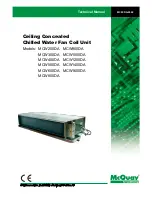
JOHNSON CONTROLS
25
FORM 160.77-O1
ISSUE DATE: 10/22/2020
SECTION 3 - MAINTENANCE
cator temperature will return to approximately ambient
temperature. Close off the system again, and start the
second evacuation.
The relatively small amount of moisture left will be
carried out through the vacuum pump and the tem-
perature or pressure shown by the indicator should
drop uniformly until it reaches a temperature of 35°F
(1.6°C) or a pressure of 5 mm Hg.
When the vacuum indicator registers this tempera-
ture or pressure, it is a positive sign that the system is
evacuated and dehydrated to the recommended limit. If
this level cannot be reached, it is evident that there is a
leak somewhere in the system. Any leaks must be cor-
rected before the indicator can be pulled down to 35°F
(1.6°C) or 5 mm Hg. in the primary evacuation.
During the primary pulldown, carefully watch the wet
bulb indicator temperature, and do not let it fall below
35°F (1.6°C). If the temperature is allowed to fall to
32°F (0°C), the water in the test tube will freeze, and
the result will be a faulty temperature reading.
REFRIGERANT CHARGING
To avoid the possibility of freezing the liquid within
the evaporator tubes when charging an evacuated sys-
tem, only refrigerant vapor from the top of the drum
or cylinder must be admitted to the system pressure.
Continue charging vapor only into the system until the
system pressure is raised above the point correspond-
ing to the freezing point of the evaporator liquid. For
water, the pressure corresponding to the freezing point
is 29 PSIG (200 kPa) for R-134a (at sea level).
While charging, every precaution must be taken to pre-
vent moisture laden air from entering the system. Fab-
ricate a suitable charging connection from new copper
tubing to fit between the system charging valve and the
fitting on the charging drum. This connection should
be as short as possible, but long enough to permit suffi-
cient flexibility for changing drums. The charging con-
nection should be purged each time a full container of
refrigerant is connected. Changing containers should
be done as quickly as possible to minimize the loss of
refrigerant.
The weight of the refrigerant charged should be record-
ed after initial charging. Refrigerant may be furnished
in cylinders containing either 30, 50, 125, 1,025 or
1750 lbs. (13.6, 22.6, 56.6, 464 or 794 kg) of refriger-
ant.
The refrigerant charge is specified for each chiller
. Charge the correct
amount of refrigerant and note the level in the evapora-
tor sight glass.
Proper refrigerant charge trimming is accomplished
while running at design full load. Ensure condenser
and economizer level settings cover the condenser
subcooler and maintain economizer liquid seal. Then
trim charge for design evaporator approach (leaving
chilled liquid temperature minus refrigerant tempera-
ture) and compressor discharge superheat.
TABLE 2 -
REFRIGERANT CHARGE
COMPRESSOR
CONDENSER
EVAPORATOR
ESTIMATE REFRIGERANT
CHARGE LBS (KGS) 1
K7 (YDHA119) and
Q3 (HF416)
BB, BC, BD, B5, B6, B7, B8
BB
8300 (3765)
BC
7800 (3538)
BD
7320 (3320)
B6
8080 (3665)
B7
7800 (3538)
B8
7520 (3411)
1 Refrigerant charge quantity and weights will vary based on tube count.
* Refer to product drawings for detailed weight information.
3










































